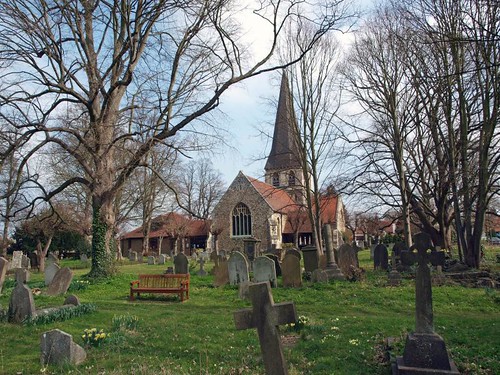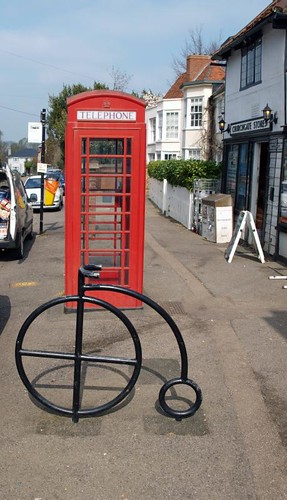ST MARY THE VIRGIN. Alas so thoroughly restored in 1878-80 that it is virtually a Victorian church. Only the fact of a crossing tower remains as evidence that Harlow belonged to that type very unusual in Essex. Between the medieval church and the present rebuilding lay another rebuilding of 1709. - CHEST. In the S transept. Italian, C17, with scenes in shallow relief and pokerwork. - STAINED GLASS. In the N vestry small C14 figure of the Virgin seated, only about 12 ins long. - PLATE. Flagons of 1618 and 1623; large Cup and Paten of 1639; two Candlesticks of 1697; Spoon of 1709. - BRASSES. An uncommonly large number collected in the N transept. Especially noteworthy: Knight and Lady c. 1430 (19-in figures); so-called Robert Doncaster d. 1490 and wife (2-ft figures); Thomas Aylmer d. 1518 and wife (10-in. figures); Richard Bugges d. 1636 and wives (3-ft figures); W. Newman, d. 1602 and wife, plate with standing figures and inscription between them: Veritas mihi dulcior vita; in the floor of the crossing Civilian and wife, late C15 (16-in. figures, perhaps of Robert Doncaster and wife). - MONUMENTS. Alexander Stafford d. 1652 and wife, with large kneeling figures facing each other, a type rather out of date in 1650. - John Wright d. 1659, wooden tablet with small figures of Faith, Hope, and Charity on top.
HARLOW. A little old-world town of much delight, it has a church full of fine things, a manor house of great interest, and a fine little Tudor chantry-house with a lovely porch and 16th century glass illustrating the months. The oldest parts of the manor house are Tudor, but it is the successor of a house given by Edward the Confessor, 900 years ago, to the Abbots of Bury St Edmunds. In a corner of the garden is a granary built by the Normans, still with its Norman doorway and windows, and with a kingpost roof of the 15th century. It was built as a chapel, the private shrine of the old abbots, who rested here on their journeys to London.
We can come to the church by an avenue of great limes or by another entrance near one of the most magnificent copper beeches in Essex. The church is in the shape of a cross, which is uncommon in this part of the county; and, though it has fragments of medieval work and a Norman window, it has been rebuilt more than once. Destroyed by fire in 1708, it was raised again in a poor style; and was finally rebuilt with a tower and spire and a fine peal of bells.
A coffin lid with a raised cross is thought to mark the grave of a rector buried in 1326, John de Stainton.
Most of the old monuments are in the transepts, a wooden tablet 250 years old in memory of a Bishop of Ely, a curious wooden monument with Faith, Hope, and Charity on pedestals in memory of John Wright in the 17th century, and sculptures of Alexander Stafford and his wife Julian at prayer. She it was who in 1630 founded the almshouses by the lychgate, still with their original bargeboards and a nail-studded door. A wooden panel which she may have seen has the Lord’s Prayer in a beautifully carved border.
Under the lectern are brass portraits of a 15th century couple and their nine children; but the great collection of old brasses is in the north transept, mounted on a board on the wall. They show over 30 figures of men and women and children, all alive in Tudor and Jacobean England. One is Robert Druncaster, secretary to Henry the Seventh; another is Thomas Aylmer with his family of 12; and a third is William Sumner of 1559, a link with the old order, for he was the last tenant of the Abbot of Bury. Two Elizabethans are here with their children, and a third is shown with Death holding a dart beside him, perhaps because he was a park-keeper and died while shooting a deer. John Gladwin is a grim-faced old man of 95, with an inscription telling of his tedious lawsuits; Robert Lawson wears a fur-lined robe; Francis Reve and his wife are kneeling; and there are big figures of Richard Bugges and his two wives, he in armour with a lace collar and a walking-stick.
A lovely little sculpture by William Theed shows a baby on a cushion in memory of John Perry Watlington who died in 1862. One of the windows is to his kinsman, the first Bishop of Melbourne. In the vestry is a 600-year-old glass panel of the Madonna, and in a big transept window is glass of many periods, 14th century canopies, Tudor badges, and scenes from Solomon’s life, lions holding shields, a portrait of Queen Anne, and a head of Charles Stuart with his martyr’s crown coming down from the sky. Another transept window has two angels of about 1700. The fine west window has modern figures of Bible characters. A splendid Italian chest stands on the floor below, fashioned in the 17th century with poker-work panels and carvings of cupids, grotesque animals, and armed men.
The church has memories of several heroes of the battlefield. We read of General Sir Godfrey Thomas who won the DSO by his gallantry near Arras in 1917; of Sir Evelyn Wood, VC, who died here; and of Colonel John Neville Marshall who won the VC a few days before the Armistice, leading parties of men under intense fire to repair a broken bridge, and falling as he rushed across it at the head of his battalion. Here was born the writer of one of the hymns that have sung their way round the world, Nearer My God to Thee. She was Sarah Adams, and lies with her sister (who wrote the tune for the hymn) and their father in a graveyard two miles away, used by the Baptists of Harlow for 200 years. It is at Foster Street.
Flickr.
We can come to the church by an avenue of great limes or by another entrance near one of the most magnificent copper beeches in Essex. The church is in the shape of a cross, which is uncommon in this part of the county; and, though it has fragments of medieval work and a Norman window, it has been rebuilt more than once. Destroyed by fire in 1708, it was raised again in a poor style; and was finally rebuilt with a tower and spire and a fine peal of bells.
A coffin lid with a raised cross is thought to mark the grave of a rector buried in 1326, John de Stainton.
Most of the old monuments are in the transepts, a wooden tablet 250 years old in memory of a Bishop of Ely, a curious wooden monument with Faith, Hope, and Charity on pedestals in memory of John Wright in the 17th century, and sculptures of Alexander Stafford and his wife Julian at prayer. She it was who in 1630 founded the almshouses by the lychgate, still with their original bargeboards and a nail-studded door. A wooden panel which she may have seen has the Lord’s Prayer in a beautifully carved border.
Under the lectern are brass portraits of a 15th century couple and their nine children; but the great collection of old brasses is in the north transept, mounted on a board on the wall. They show over 30 figures of men and women and children, all alive in Tudor and Jacobean England. One is Robert Druncaster, secretary to Henry the Seventh; another is Thomas Aylmer with his family of 12; and a third is William Sumner of 1559, a link with the old order, for he was the last tenant of the Abbot of Bury. Two Elizabethans are here with their children, and a third is shown with Death holding a dart beside him, perhaps because he was a park-keeper and died while shooting a deer. John Gladwin is a grim-faced old man of 95, with an inscription telling of his tedious lawsuits; Robert Lawson wears a fur-lined robe; Francis Reve and his wife are kneeling; and there are big figures of Richard Bugges and his two wives, he in armour with a lace collar and a walking-stick.
A lovely little sculpture by William Theed shows a baby on a cushion in memory of John Perry Watlington who died in 1862. One of the windows is to his kinsman, the first Bishop of Melbourne. In the vestry is a 600-year-old glass panel of the Madonna, and in a big transept window is glass of many periods, 14th century canopies, Tudor badges, and scenes from Solomon’s life, lions holding shields, a portrait of Queen Anne, and a head of Charles Stuart with his martyr’s crown coming down from the sky. Another transept window has two angels of about 1700. The fine west window has modern figures of Bible characters. A splendid Italian chest stands on the floor below, fashioned in the 17th century with poker-work panels and carvings of cupids, grotesque animals, and armed men.
The church has memories of several heroes of the battlefield. We read of General Sir Godfrey Thomas who won the DSO by his gallantry near Arras in 1917; of Sir Evelyn Wood, VC, who died here; and of Colonel John Neville Marshall who won the VC a few days before the Armistice, leading parties of men under intense fire to repair a broken bridge, and falling as he rushed across it at the head of his battalion. Here was born the writer of one of the hymns that have sung their way round the world, Nearer My God to Thee. She was Sarah Adams, and lies with her sister (who wrote the tune for the hymn) and their father in a graveyard two miles away, used by the Baptists of Harlow for 200 years. It is at Foster Street.
Flickr.



No comments:
Post a Comment